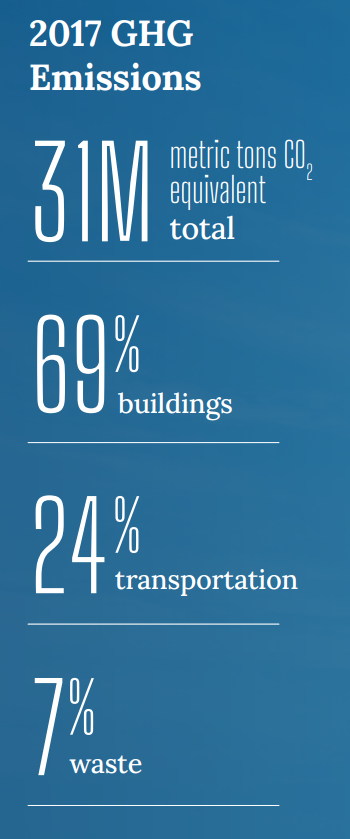Electrify Chicago
An independent tool for viewing City of Chicago building data
According to the
2022 Chicago Climate Action Plan,
69% of Chicago's emissions come from buildings, making
building emissions our biggest challenge and our biggest opportunity as a city
to tackle climate change. At Electrify Chicago, we showcase building performance using
publicly available data supplemented by community-submitted photographs and building
owners.
Start by looking at Chicago's buildings with the highest greenhouse gas intensity i.e. emissions per square foot. Large, efficient, buildings can perform much better than very inefficient small buildings on this metric.
New Article
📰 $30 Million In Missed Fines
The City Of Chicago failed to collect $30 million in potential fines from the building benchmarking ordinance, reducing transparency and accountability.
Legislative update! 🎉
As of late January 2024, legislation is being introduced to require new use more efficient forms of water and space heating, via the Clean And Affordable Buildings Ordinance (CABO), which will reduce the number of highly polluting and inefficient buildings that end up on this site.
If you're in Chicago,
write to your alderman to support the CABO!
Chicago Buildings by Greenhouse Gas Intensity
Note: Data includes large Chicago buildings with data from 2022, unless explicitly stated otherwise.
Note: This data only includes buildings whose emissions are reported
under the
Chicago Energy Benchmarking Ordinance. According to the City “As of 2016,
this list includes all commercial, institutional, and residential buildings larger than
50,000 square feet.” This dataset is also then filtered to only buildings with
reported emissions > 1,000 metric tons CO2 equivalent.
The latest year of data is from 2022, but we update the site regularly when new data is available, and some buildings may have failed to report that year, and only have older data available.
| Property Name / address | Primary Property Type |
Greenhouse Gas Intensity (kg CO2 eq./sqft) |
Total Greenhouse Emissions (metric tons CO2 eq.) |
|---|---|---|---|
|
Two North LaSalle
2 N LaSalle St
| Office | 5.6 kg/sqft
Lowest 35%
| 4,369 tons
Highest 8%
|
|
Randolph-Wells Building
205 W Randolph St
| Office | 5.6 kg/sqft
Lowest 35%
| 1,120 tons
Highest 41%
|
|
77 West Wacker Drive
77 W Wacker Dr
| Office | 5.6 kg/sqft
Lowest 35%
| 6,691 tons
Highest 5%
|
|
One South Wacker
1 S Wacker
| Office | 5.6 kg/sqft
Lowest 35%
| 7,462 tons
Highest 4%
|
|
131 S Dearborn 3
131 S Dearborn
| Financial Office | 5.6 kg/sqft
Lowest 35%
| 1,514 tons
Highest 31%
|
|
IL0303ZZ-METCALFE FED BLDG
🕰️
77 W Jackson
| Office | 5.6 kg/sqft | 4,465 tons |
|
850 W EASTWOOD AVE
850 W EASTWOOD AVE
| Multifamily Housing | 5.6 kg/sqft
Lowest 35%
| 1,363 tons
Highest 35%
|
|
455 E WATERSIDE DR
455 E WATERSIDE DR
| Multifamily Housing | 5.5 kg/sqft
Lowest 33%
| 2,795 tons
Highest 15%
|
|
Michael M Byrne Elementary School
5329 S Oak Park Avenue
| K-12 School | 5.5 kg/sqft
Lowest 33%
| 429 tons
Lowest 19%
|
|
A.M. 1980
🕰️
1980 N Milwaukee Ave
| Multifamily Housing | 5.5 kg/sqft | 604 tons |
|
The Apartments at Lincoln Common
2345 N Lincoln Ave
| Multifamily Housing | 5.5 kg/sqft
Lowest 33%
| 2,035 tons
Highest 23%
|
|
Sunnycourt Condominiums
906 934 W Sunnyside
| Multifamily Housing | 5.5 kg/sqft
Lowest 33%
| 418 tons
Lowest 18%
|
|
San Francisco Hall-ID# 254170
🕰️
(Loyola)
6327 N Kenmore Ave
| Residence Hall/Dormitory | 5.5 kg/sqft | 507 tons |
|
1411 State Parkway Condominium Association
🕰️
1411 N State Parkway
| Multifamily Housing | 5.5 kg/sqft | 231 tons |
|
Prairie Ave Lofts
221 E Cullerton Ave
| Multifamily Housing | 5.5 kg/sqft
Lowest 33%
| 998 tons
Highest 45%
|
Data Source:
Chicago Energy Benchmarking Data
